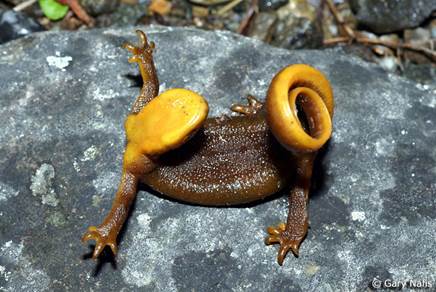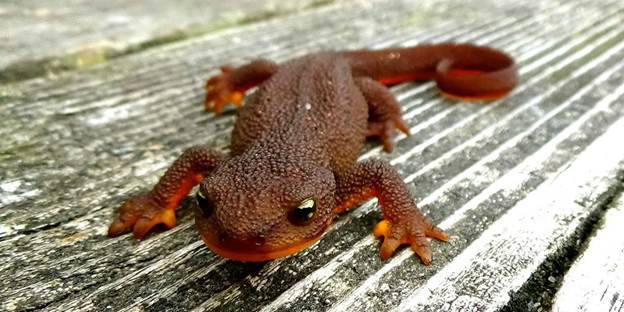Fillet of a fenny snake,
In the caldron boil and bake;
Eye of newt, and toe of frog,
Wool of bat, and tongue of dog,
Adder’s fork, and blind-worm’s sting,
Lizard’s leg, and owlet’s wing,—
For a charm of powerful trouble,
Like a hell-broth boil and bubble.
– The three witches, Macbeth. William Shakespeare.
Rough-skinned newts are the most commonly encountered salamander of western Washington and Oregon. Their range extends from Alaska south to about Santa Cruz, California. There are some records of them from just over the Cascade crest, but isolated observations in Idaho and Montana are thought to be introductions. A separate subspecies can be found around Crater Lake, OR – though whether this subspecies is a valid designation appears to be in dispute. They are pretty adaptable and can be found from sea level up to about 9,000 ft elevation.
In general, newts have rougher skin than other salamanders and they have the ability to regenerate limbs, eyes, spinal cords, hearts, intestines, and upper and lower jaws. The genus Taricha(western) and Notophthalmus (eastern) are the only US newts, totaling 7 species. In his book – Of Scientists and Salamanders (1969) V.C. Twitty leads us through the odd capabilities of limb regeneration in newts and salamanders and the curious – old school ontogeny studies of grafting limbs/tails of different larval species on one another. It’s like reading some odd, amphibian Frankenstein story. He does, however, turn his attention to the long-range homing abilities of newts by marking them, taking them into other CA watersheds, and documenting their return to their home streams over 1,500 ft. ridges and several miles.
Males are about 6.5 inches in total length and females are a bit smaller. Their skin is dark brown and bumpy on top with a bright, orange-yellow belly. Adults migrate to breeding ponds from December to July, depending on the climate where they live. Males will arrive at the ponds first and stay longer than females. During courtship the male will grasp the female from above with his forelimbs, stroke her with his hind limbs, and rub her nose with his chin – often with his mouth open. After he dismounts the male will deposit a single spermatophore (sperm package) in front of the female who will then pick it up with her cloacal lips.
Following internal fertilization the female will lay single eggs scattered around the pond attached to stems or leaves of vegetation. This may reduce the loss of eggs by accident or predation in contrast to laying all eggs in one cluster. Eggs hatch in 20-26 days and the aquatic larvae will metamorphose into terrestrial forms toward the end of summer. In some northern areas where summers are short, the young may over-winter as aquatic forms. They can live up to 12 years.
Newts sometimes congregate in ponds – called “newt rafts” that can include up to 5,000 individuals. These aggregations occur after the breeding season, so are not related to reproduction and may include larvae, subadults, and adults. The reason for these gatherings is unclear – newt pool party??
You can often encounter this critter because it is very nonchalant about wandering around on the forest floor during the daytime because of its toxic skin. The toxin is not absorbed through our skin so you can pick them up – though the WA DNR site warns: Newts can be handled safely but care should be taken with small children prone to putting things in their mouths. After handling any amphibian, one should avoid touching the mucus membranes of the eyes, nose and mouth until hands have been washed.
Don’t do this – as reported in the Journal of the American Medical Association:
A 29-year-old man drank approximately 150 mL of whiskey at about 11 AM July 9, 1979. At 6 PM he swallowed a 20-cm newt on a dare. Within ten minutes he complained of tingling of the lips. During the next two hours he began complaining of numbness and weakness and stated that he thought he was going to die. He refused to be transported to a hospital and was left alone for 15 minutes and then experienced cardiopulmonary arrest. Resuscitation measures were initiated, but failed.
This newt produces a neurotoxin called tetrodotoxin that is similar to that produced by pufferfish. The toxin blocks the flow of sodium in nerve cells and inhibits firing action, which can lead to paralysis and death. When they encounter a predator this newt will posture by arching its nose towards its tail -showing its orange underbelly – warning of its poison (called the uken reflex – unken, German word for fire-bellied toads).

Interestingly, the common garter snake is immune to its poison and a bit of an evolutionary arms race has occurred between the two – the newt increasing its toxicity and the snake improving its defenses. Thus, the newt produces much more toxin than needed to disable a predator and one newt contains enough toxin to kill two humans. Though because of certain internal mechanisms, this level of toxicity seems to have reached a maximum in newts. Ducks, fish, and frogs have been found dead with rough-skinned newts in their stomachs.
This is an awesome two minute video on newt toxicity: https://www.youtube.com/watch?v=kvBi5Wv8-qg
Because they are so common I’ve found them all around Puget Sound and the Cascades – second growth forest; old growth forest; in wetlands; under rocks, logs, and car tires; and one that got into my backpack at a lunch stop during field work. I’ve always picked them up – well because that’s what you do with amphibians or reptiles you encounter. They are slow and casual in their demeanor – not in any particular hurry, it appears.
And given their toxicity – what’s the rush?
